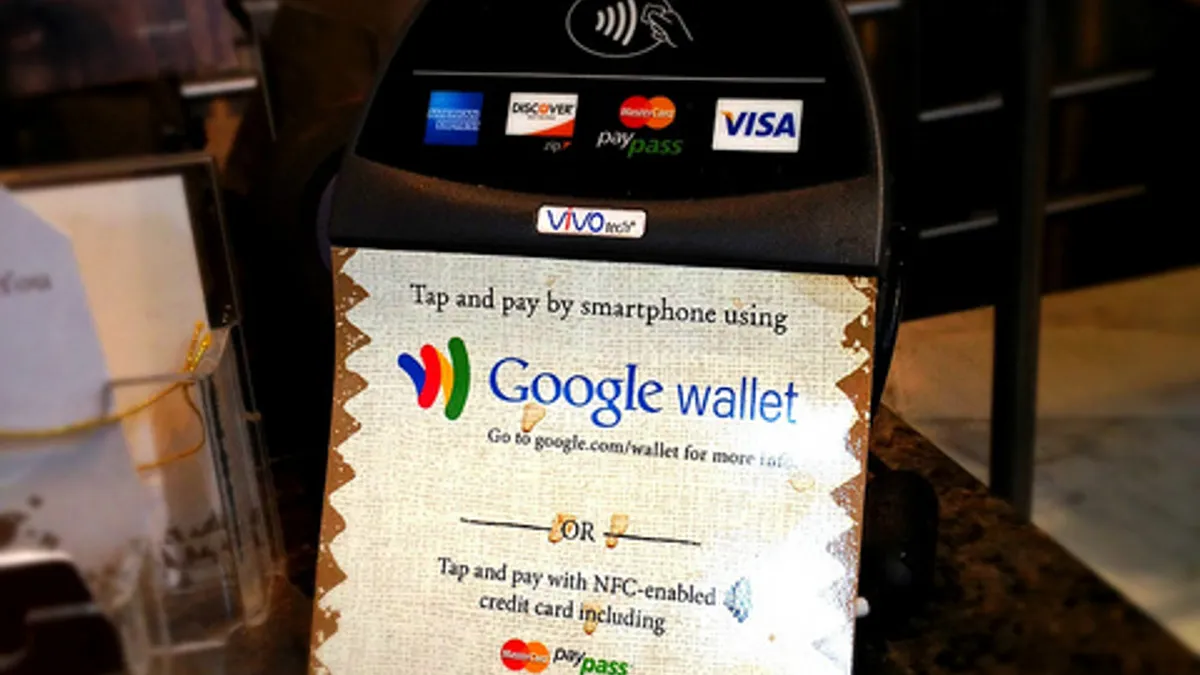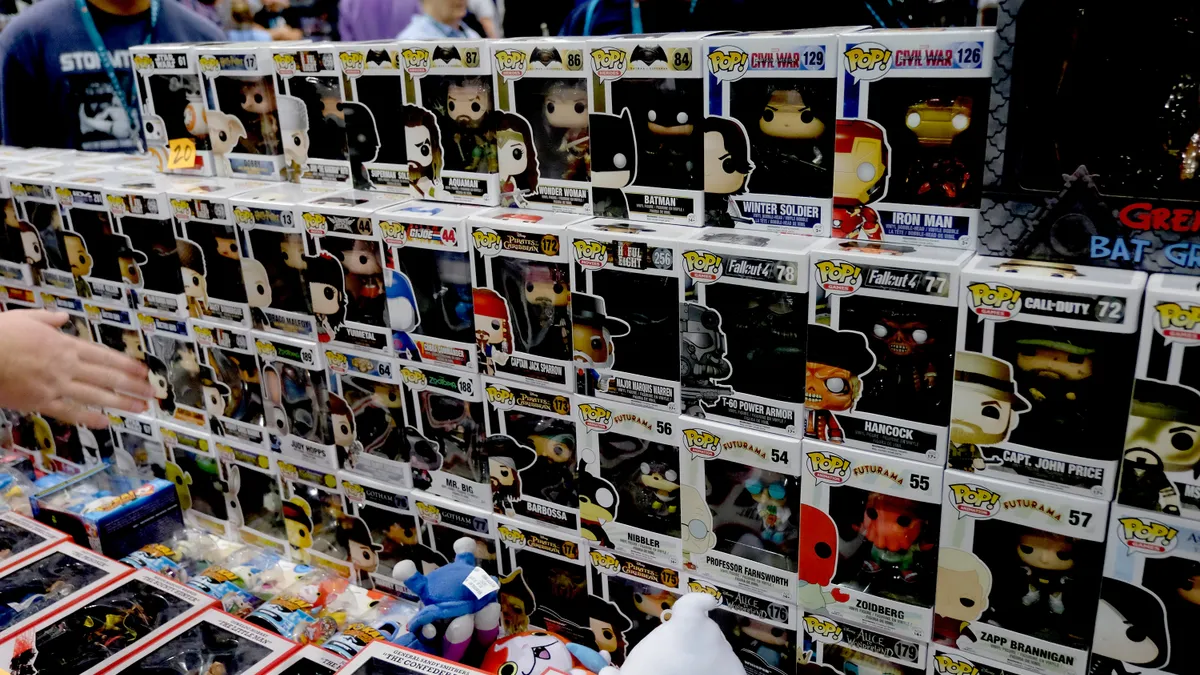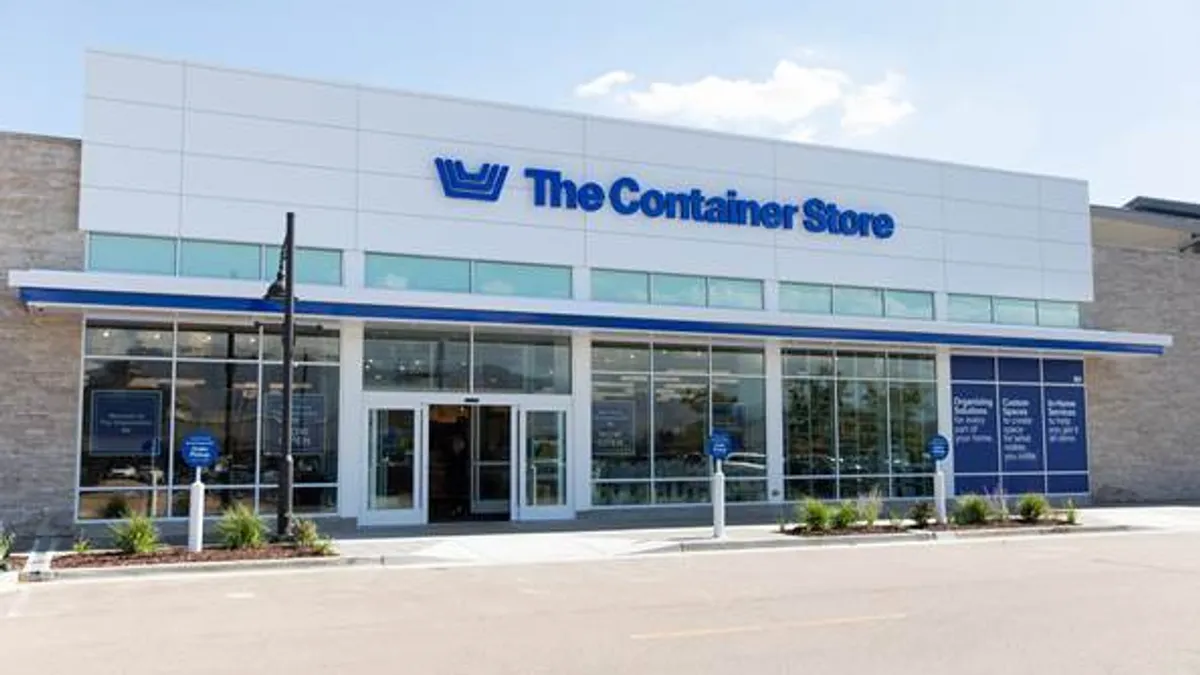You’ve heard of Star Wars, the much-anticipated episode in the franchise opening in December, which promises to offer a bonanza both to eager fans and retailers selling merchandise.
But the “wallet wars” is a complex real-life set of circumstances that have many retailers wondering whether the myriad of mobile payment options is a chance at a bonanza or a risk of a boondoggle.
Retail Dive investigates the trenches of this high-tech battlefield. The company that takes advantage mobile wallets' capacity to make shopping easier and better for customers, beyond payments, will be the winner.
Mobile payments, security and the effect of EMV
Mobile e-commerce is growing, but activity has been largely relegated to researching and comparing goods, rather than purchase. That will change if smartphone users find that shopping on mobile is easier and secure, or secure enough.
“Mobile e-commerce has been growing by double-digit percentages year after year, so as we see this increase in usage and growth, we're also going to see growing demand for apps and technologies that make the mobile shopping experience better,” Ben Wong, VP of marketing at Bindo, told Retail Dive in an email. “So things like more secure payment portals, easier payment methods (tap-to-pay, etc), and more mobile integration into the physical store itself. All of these are things are idea that could be brought together and provided by a proper digital wallet.”
Wong says that consumers need time to accept the notion that mobile payments are as safe as the plastic in their physical wallets.
“One of the big barriers right now is consumer mentality towards security and the idea of storing money or access to money on their phones,” he says. “But this is something that can only be overcome with time and improved technology and adoption, because at the end of the day, I don’t think we’ve yet found a solution that beats the simplicity and convenience of plastic credit cards.”
But the push to the use of EMV cards by sometime next month could also lead to wider use of mobile payments because EMV makes those plastic cards a bit more of a hassle. As Nicko van Someren, CTO of Good Technology, told Retail Dive earlier this year, it’s usability, not security, that until now has been the biggest obstacle so far to mobile payments, in store and out.
"In practice, I think that usability is going to be more of an issue than security,” van Someren said. “The existing security models for credit card transactions, particularly in North America, [were] pretty poor, and yet consumers are comfortable with the system. Most of the mobile payments systems released to date have had better security than existing magnetic stripe cards. And often that has been their downfall, since their security has hampered usability.”
At brick-and-mortar point-of-sales systems anyway, the improvements in wallets like Apple Pay, Android Pay, and even Samsung Pay plus the new clunkiness of using EMV-enabled cards may have flipped the script.
The payment method retailers are looking for
What retailers and their CMOs haven’t necessarily cottoned onto is the enormous potential for mobile wallets in their marketing efforts.
While early adopting retailers like Bloomingdale’s, Gap, McDonald’s, Sears, and Sephora have been assertive in leveraging mobile wallets like Apple Pay for marketing, 2015 (and 2016) will see a bump in the numbers of retailers jumping in, according to a February report from Forrester Research, “The Future Of Mobile Wallets Lies Beyond Payments.”
"Back in 2011, Forrester anticipated that massive disruption in the mobile payment space would emerge slowly but steadily," says report author Thomas Husson. “We expected the digital wallet opportunity to go way beyond mobile payments by enabling smarter and more efficient commerce experience through the delivery of value-added services — before, during, and after the payment moment.”
That’s now exquisitely possible, according to Mark Tack, VP of marketing at mobile marketing firm Vibes, thanks to Android Pay and Apple Wallet. And the utility of mobile wallets will be important to retailers regardless of their own app’s effectiveness, say both Tack and Husson.
“No matter how good your own app is, the reality is that only a small subset of your customer base will use it,” Husson says.
That even goes for Starbucks fabled app, writes Ralph Dangelmaier, CEO of global payments processing company BlueSnap, in VentureBeat.
“Starbucks’ success reminds me of AOL, Netscape, and Napster in the early days of the Internet,” he writes. “Their digital ‘wallet’ has the trappings of an early technology champion that will fall prey to companies that think bigger and execute later. A world with one mobile payment app per company would be unfeasible and inconvenient for consumers, no matter how many Frappuccino’s they guzzle per week. Don’t believe for a second that Apple, Google, Samsung, PayPal, Alibaba and the other Wallet Warriors will tolerate a payment ecosystem in which every major company processes its own transactions.”
There remains a place for well designed, well working mobile retail apps, says Tack. But their limits can be taken up by these mobile wallets, and retailers should not shirk either.
“Retailers ask, ‘What role should my app play?’ and our take is ‘You need both,’” he says. “It’s a symbiotic role. But all marketing roads lead to mobile wallet.” That’s because, Tack says, the mobile wallet organizes everything in one place, few if any shoppers will be hitting individual retailer apps with such frequency, and, importantly, users seldom delete the content from their mobile wallets.
Down to the big two?
Approaching the autumn of 2015 there may actually be only two such “warriors” standing, according to Tack. He believes that Android Pay, formerly “Google Wallet,” and Apple’s Wallet, formerly Passbook, have enormous potential to boost retail marketing efforts because of their capacity to include loyalty cards, coupons, and payment in one easy space. While Apple is the leader here, says Tack, with its Apple Pay and Passbook options already enjoying a significant amount of use, Google’s Android Pay is destined to dominate Android phones, especially when it becomes preloaded on devices in the near future, as is promised.
“When most people say ‘wallet wars’ they tend to go to the payment side,” Tack says, and that includes latecomer Samsung Pay and yet-to-launch CurrentC. But the additional capabilities of Android Pay and Apple Wallet set them apart, according to Tack. (And CurrentC’s approach of limiting use to participating retailers limits its usability in marketing, just another in its long list of self-inflicted wounds.)
“Both of these apps have other value-added capabilities,” he told Retail Dive. “In the case of Passbook, Apple has done a good job of training us to use it for things like event tickets and a lot of things. We’re starting to get used to that. We have actually seen a 1,143% increase in last 12 months in pieces of content — coupons and loyalty cards — saved in Passbook.”
What’s in a name
Tack sides with Shakespeare here, and says that there will be little confusion about the new names that Google and Apple have given their wallets. That's because, he says, even Google’s emphasis on “pay” from “wallet” will mean little as Android users realize what it can do. Apple’s corner on the word “Wallet” is especially helpful, though, Tack says, because it mirrors people’s wallets today — stuffed as they are with store loyalty cards, credit cards, and coupons.
“It's the 'Cozstanza wallet' effect,’” says Tack. “The overflowing wallet. It’s insanity, especially, to try to shop our paper coupons. So to organize and mobilize all that content, there’s benefit, first just from a convenience standpoint. But the second big benefit is that these wallets are location aware, so you can get a reminder from a store that you have a coupon or a sale when you’re nearby.”
That's quite a change from what happens when most people pass by a store now, with a crumpled coupon jammed in their bag or back pocket, possibly expired but no doubt forgotten.






















